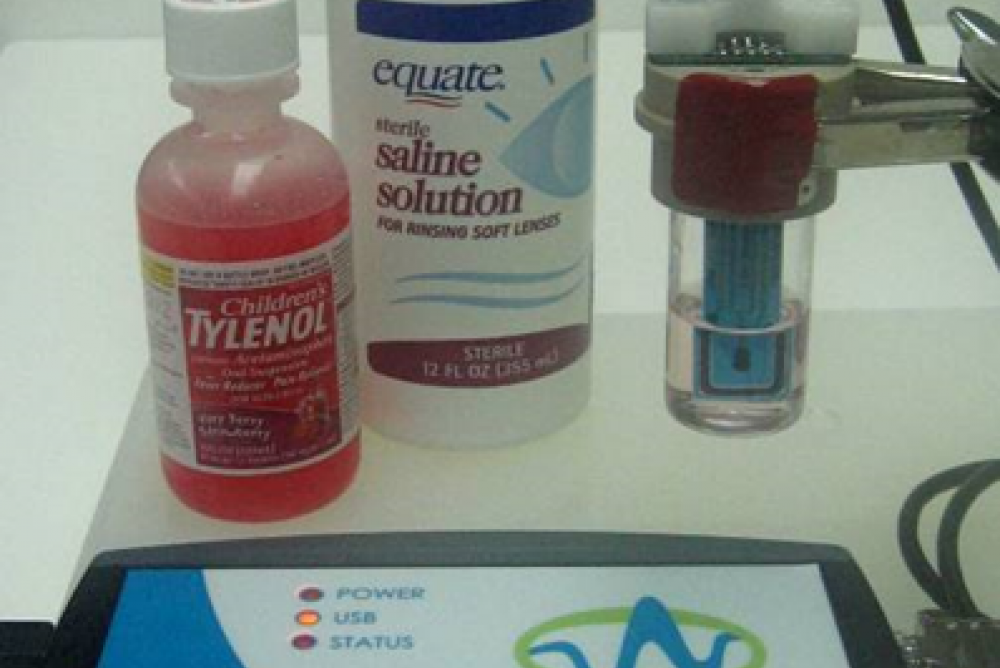REACWARE

1Abstract
This experiment demonstrates the use of modern electroanalytical chemistry to determine the active ingredient in a popular children’s pain relief medication.
Designed for use in an instructional laboratory setting, this procedure describes the use of cyclic voltammetry to verify the concentration of acetaminophen (4-acetamidophenol) indicated on the suspension label. Advantages of the approach used here include the use of inexpensive and disposable screen-printed carbon electrodes and the use of an inexpensive consumer-grade supporting electrolyte solution that is widely available on the mass market. The only reagent grade chemical required for this procedure is a small amount of pure 4-acetamidophenol.
Back To Top
2Introduction
Acetaminophen is an active ingredient in several over-the-counter pain relief medications, including the well-known brand, Tylenol®. Acetaminophen has largely replaced aspirin (acetylsalicylic acid) as the medication of choice for children and infants because aspirin has, in some cases, been linked to the development of Reye’s Syndrome.
For easier delivery to young children, acetaminophen is often formulated as an oral suspension, which is a viscous aqueous suspension containing various colorings and flavorings (see Figure 1). A typical sample of the suspension has an acetaminophen concentration in the range from 30 to 100 g/L. In this lab experiment, an electrochemical method known as cyclic voltammetry (CV)
is used to determine the acetaminophen concentration in a sample of the medication, and the result is compared with the stated value provided by the manufacturer on the medication package.
3Background
Acetaminophen, with a formal chemical name of 4-acetamidophenol, is an electroactive molecule that can be oxidized. Acetaminophen (A) can be oxidized to the quinone form (B), called N-acetyl-4-quinoneimine (abbreviated as NAPQI) in a two-electron, two-proton electron transfer process where, in the presence of an acid catalyst, NAPQI (B) is rapidly converted to a hydrate (C) called N-acetyl-4-quinoneimine hydrate (see Figure 2). The two-electron oxidation of acetaminophen (A) is observed as an anodic (oxidizing) current when the electrode potential is swept in the positive direction.
In an acidic solution (pH~2), the NAPQI product (B) is quickly converted to the hydrate (C). Because the hydrate is electrochemically-inactive, it is not possible to convert the hydrate back to acetaminophen via reduction. That is, it is not possible to reverse the process by sweeping the electrode potential back in the negative direction. In an electrochemical context, this type of reaction is said to be irreversible.
At higher pH, however, the NAPQI (B) intermediate is not as rapidly converted to the hydrate. Unlike the hydrate (C), the NAPQI intermediate (B) is, in fact, electroactive. This means that the NAPQI (B) can be converted back to acetaminophen (A) in a two-electron, two-proton reduction process at the electrode (see Figure 2). This reversal is accomplished by sweeping the electrode potential back to negative potentials at which the NAPQI (B) is reduced to acetaminophen (A).
With less acid catalyst present at higher pH, the rate of hydration decreases, resulting in a higher percentage of NAPQI (B) molecules remaining intact and in the vicinity of the electrode surface. Thus, as the solution pH increases, it becomes possible to observe a cathodic (reducing) current at the electrode, and the electrochemical process changes from being irreversible to being quasi-reversible.
In this experiment, cyclic voltammetry (CV)
is used to observe both the anodic (oxidizing) current and the cathodic (reducing) current as the potential of the electrode is swept first in the positive direction and then back in the negative direction (see Figure 3). Because of its dependence upon the pH of the solution, the cathodic current is not a good choice for quantitative analysis. The anodic peak current, however, can be used as an analytical signal that is proportional to the concentration of the acetaminophen (A) in the solution.
As is typical in most analytical assays, a set of standard solutions of the analyte (acetaminophen) are prepared and analyzed, and then a calibration curve is constructed to show the relationship between the signal (i.e., the anodic current) and the analyte concentration. After establishing this relationship, a dilute solution of the children’s pain relief medication is prepared and analyzed, and the analyte concentration in the suspension is determined.

